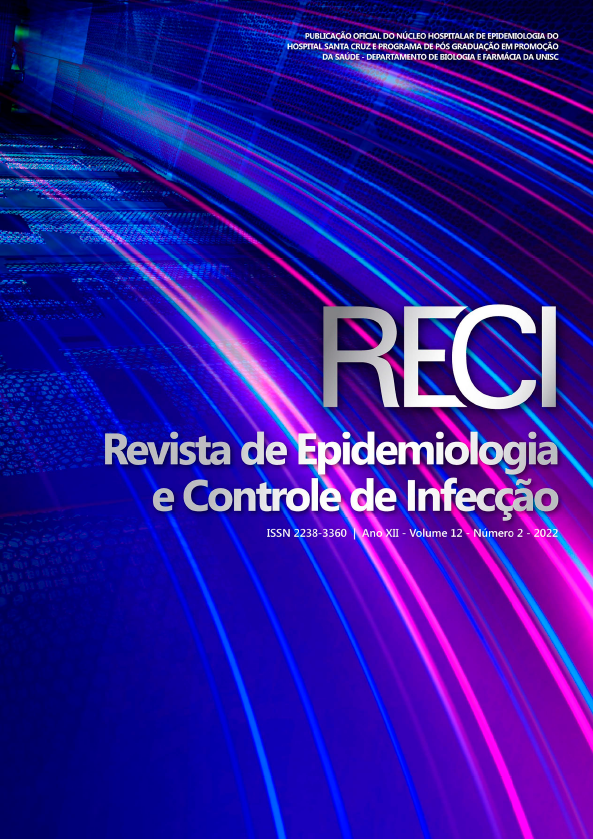COVID-19 infection rate and time spent at home: analysis of the beginning of the pandemic
DOI:
https://doi.org/10.17058/reci.v12i2.16290Keywords:
Epidemiology, Pandemics, Coronavirus Infections, Mortality.Abstract
Background and Objectives: Evidence suggests that the failure of epidemiological control impedes the resumption of socioeconomic activities. Therefore, this study aimed to describe epidemiological aspects and the pattern of mobility on each continent and to verify the association between the COVID-19 infection rate and time spent at home. Methods: We analyzed reports from Global Positioning System of 97 countries and their epidemiological indicators until May 27, 2020. Results: Cases of COVID-19 ranged from 22 to 1,745,803, and deaths ranged from 0 to 102,107. The highest rates per 100,000 population were observed in Europe and America. Approximately 54% of COVID-19 cases occurred in America and 51% of deaths in Europe. Countries reduced mobility in retail and recreation (-43.45%±20.42%), grocery and pharmacy (-17.95%±20.82%), parks (-18.77%±37.34%), transit stations (-43.09%±20.31%), workplaces (-21.74%±19.92%), and increased time spent at home (13.00%±8.80%). Linear regression showed that European inhabitants stayed at home less when compared those on the American continent (β=-4.933, SE=0.976, p<.001). In addition, every unit increase in the infection rate per 100,000 population increased 0.005 points in the mean time spent at home (β=0.005, SE=0.001, p<.001). Conclusions: We provide evidence that increased infection rate of COVID-19 is associated with increased length of stay at home. As a main lesson, COVID-19 showed that in the absence of pharmacological resources, government authorities need to act quickly to contain the spread of infectious diseases.
Downloads
References
World Health Organization [WHO]. Coronavirus disease 2019 (COVID-19): situation report, 30; 2020. https://www.who.int/emergencies/diseases/novel-coronavirus-2019/situation-reports
Aquino EML, Silveira IH, Pescarini JM, et al. Social distancing measures to control the COVID-19 pandemic: potential impacts and challenges in Brazil. Cien Saude Colet. 2020;25:2423-2446. https://doi.org/10.1590/1413-81232020256.1.10502020.
Finazzi F, Fassò A. The impact of the Covid‐19 pandemic on Italian mobility. Significance (Oxford, England). 2020;17(3):17. https://doi.org/10.1111/1740-9713.01400.
Carnut L, Mendes Á, Guerra L. Coronavirus, Capitalism in Crisis and the Perversity of Public Health in Bolsonaro's Brazil. Int J Health Serv. 2021;51(1):18-30. https://doi.org/10.1177/0020731420965137.
Gori Maia A, Marteleto L, Rodrigues CG, et al. The short-term impacts of coronavirus quarantine in São Paulo: The health-economy trade-offs. PLoS One .2021;16(2):e0245011. https://doi.org/10.1371/journal.pone.0245011.
Correia S, Luck S, Verner E. Pandemics Depress the Economy, Public Health Interventions Do Not: Evidence from the 1918 Flu; 2020. https://papers.ssrn.com/sol3/papers.cfm?abstract_id=3561560.
Lo Muzio L, Ambosino M, Lo Muzio E, et al. SARS-CoV-2 Reinfection Is a New Challenge for the Effectiveness of Global Vaccination Campaign: A Systematic Review of Cases Reported in Literature. Int J Environ Res Public Health. 2021;18(20):11001. https://doi.org/10.3390/ijerph182011001.
Callaway E. Could new COVID variants undermine vaccines? Labs scramble to find out. Nature 2021:177-178. https://doi.org/10.1038/d41586-021-00031-0.
Google. Covid-19: Community Mobility Reports; 2020. https://www.google.com/covid19/mobility/.
Worldometer. Covid-19 coronavirus pandemic; 2020. https://www.worldometers.info/coronavirus/.
Our World in Data. Coronavirus (COVID-19) Cases: statistics and research; 2020. https://ourworldindata.org/covid-cases2020.
International Monetary Fund [IMF]; 2020. https://pt.countryeconomy.com/paises/grupos/fmi.
Knoema. World Data Atlas; 2020. https://pt.knoema.com/2020.
Bulfone TC, Malekinejad M, Rutherford GW, et al. Outdoor Transmission of SARS-CoV-2 and Other Respiratory Viruses: A Systematic Review. J Infect Dis. 2021;223(4):550-561. https://doi.org/10.1093/infdis/jiaa742.
Faridi S, Niazi S, Sadeghi K, et al. A field indoor air measurement of SARS-CoV-2 in the patient rooms of the largest hospital in Iran. Sci Total Environ. 2020:138401. https://doi.org/10.1016/j.scitotenv.2020.138401.
Ehsanifar M. Airborne aerosols particles and COVID-19 transition. Environ Res. 2021;200:111752. https://doi.org/10.1016/j.envres.2021.111752.
Guo ZD, Wang ZY, Zhang SF, et al. Aerosol and Surface Distribution of Severe Acute Respiratory Syndrome Coronavirus 2 in Hospital Wards, Wuhan, China, 2020. Emerg Infect Dis. 2020;26(7):1583-91. https://doi.org/10.3201/eid2607.200885.
World Health Organization [WHO]. Modes of transmission of virus causing COVID-19: implications for IPC precaution recommendations: scientific brief. https://www.who.int/news-room/commentaries/detail/modes-of-transmission-of-virus-causing-covid-19-implications-for-ipc-precaution-recommendations.
Tabatabaeizadeh S-A. Airborne transmission of COVID-19 and the role of face mask to prevent it: a systematic review and meta-analysis. Eur J Med Res. 2021;26(1):1. https://doi.org/10.1186/s40001-020-00475-6.
Cousins S. New Zealand eliminates COVID-19. Lancet. 2020;395(10235):1474. https://doi.org/10.1016/S0140-6736(20)31097-7.
Idrovo AJ, Manrique-Hernández EF, Fernández Niño JA. Report from Bolsonaro's Brazil: The Consequences of Ignoring Science. Int J Health Serv. 2021;51(1):31-6. https://doi.org/10.1177/0020731420968446.
Sabino EC, Buss LF, Carvalho MPS, et al. Resurgence of COVID-19 in Manaus, Brazil, despite high seroprevalence. Lancet. 2021;397(10273):452-455. https://doi.org/10.1016/s0140-6736(21)00183-5.
Buss LF, Prete CA Jr., Abrahim CMM, et al. Three-quarters attack rate of SARS-CoV-2 in the Brazilian Amazon during a largely unmitigated epidemic. Science. 2021;371(6526):288-292. https://doi.org/10.1126/science.abe9728.
Faria NR, Claro IM, Candido D, et al. Genomic characterisation of an emergent SARS-CoV-2 lineage in Manaus: preliminary findings; 2021. https://virological.org/t/genomic-characterisation-of-an-emergent-sars-cov-2-lineage-in-manaus-preliminary-findings/586.
Francisco RDS, Benites LF, Lamarca AP, et al. Pervasive transmission of E484K and emergence of VUI-NP13L with evidence of SARS-CoV-2 co-infection events by two different lineages in Rio Grande do Sul, Brazil. Virus Res. 2021;296:198345. https://doi.org/10.1016/j.virusres.2021.198345.
Downloads
Published
How to Cite
Issue
Section
License
Copyright (c) 2022 Vinícius Nagy Soares

This work is licensed under a Creative Commons Attribution 4.0 International License.
The author must state that the paper is original (has not been published previously), not infringing any copyright or other ownership right involving third parties. Once the paper is submitted, the Journal reserves the right to make normative changes, such as spelling and grammar, in order to maintain the language standard, but respecting the author’s style. The published papers become ownership of RECI, considering that all the opinions expressed by the authors are their responsibility. Because we are an open access journal, we allow free use of articles in educational and scientific applications provided the source is cited under the Creative Commons CC-BY license.


